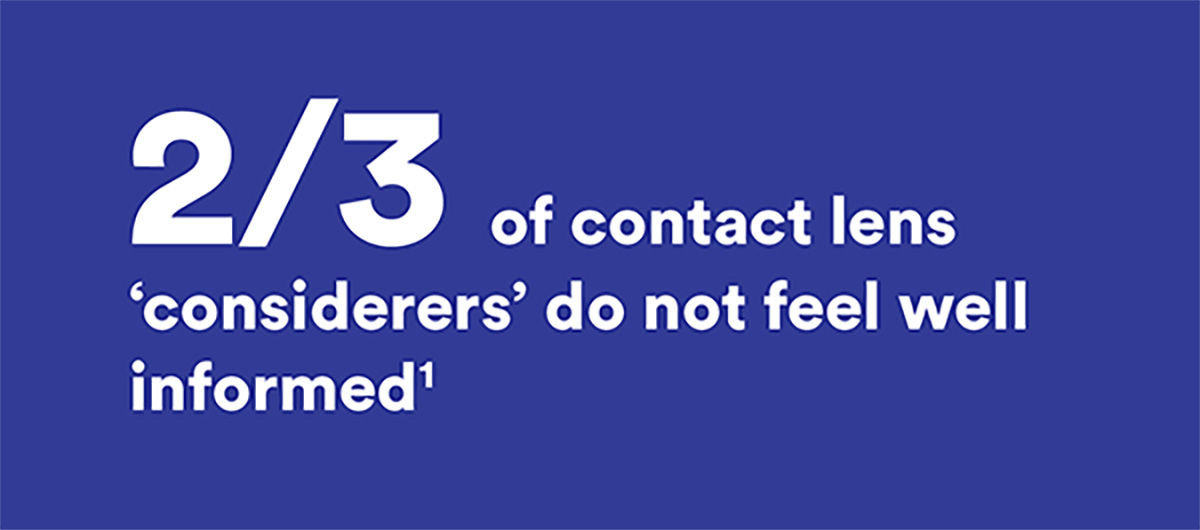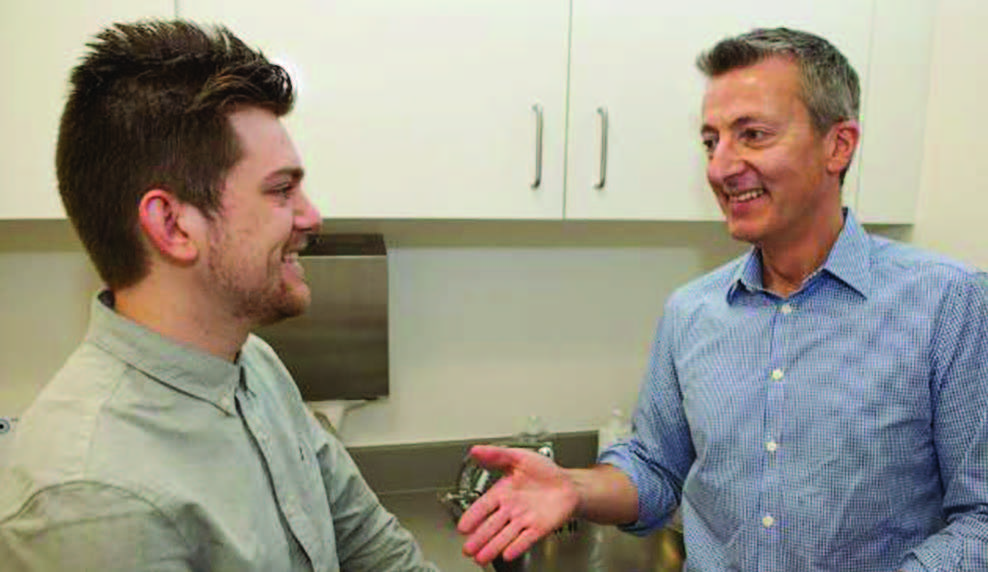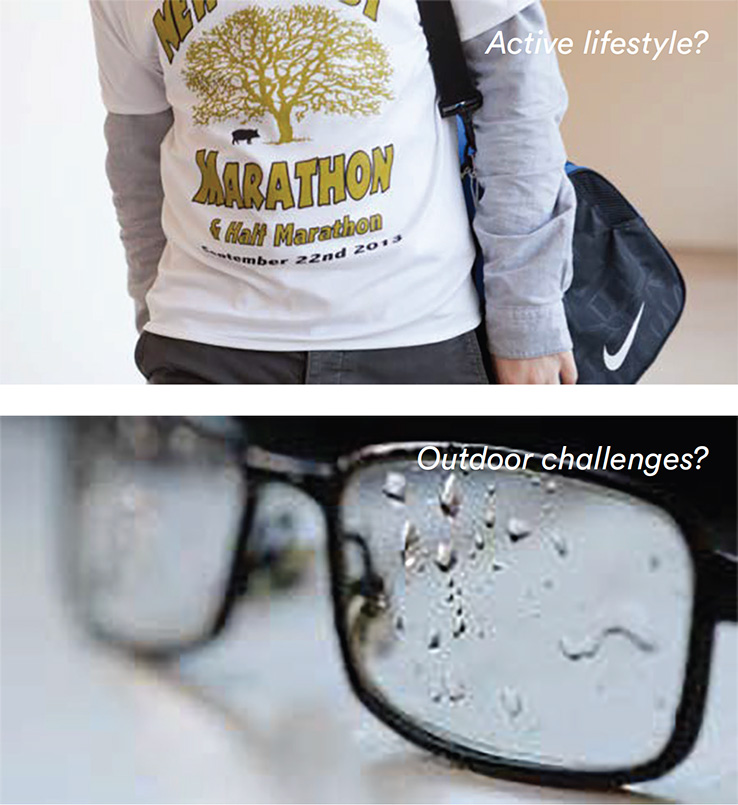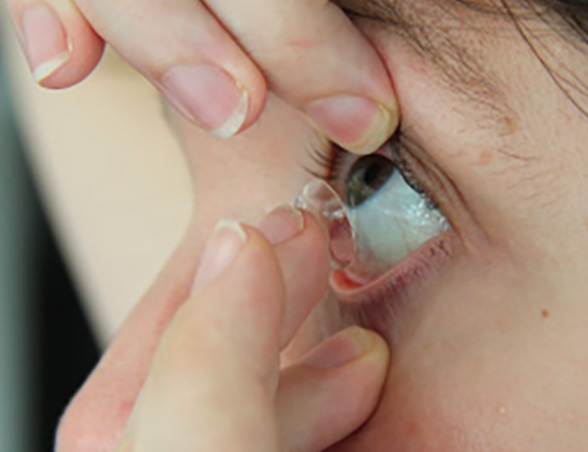By Clair Bulpin and Theresa Cox
Why initiate a contact lens conversation?

Research shows that the benefits of contact lenses (visual performance, freedom and confidence) are not consistently being communicated.
- Only 11% of eye care practitioners discuss contact lenses with all their patients.2
- 59% of patients want their practitioners to give them more information.1
Why should we initiate the contact lens conversation?

If prompted, nearly 9 in 10 (88% of patients) are interested in trialling lenses and one in three will go on to purchase.3
If patients don’t initiate a contact lens discussion, is it right to assume they are simply not interested?
It is far more likely that if contact lenses are never offered, patients simply believe they are not suitable candidates.
Who should wear contact lenses?

All patients deserve the opportunity to experience the potential life-changing moment when they experience clear vision without their spectacles for the first time. To do this:
- Give all suitable patients the option of contact lenses.
- Avoid being influenced by your own perceived barriers when deciding on your patients’ behalf whether they are interested or not.
- Remember part-time wearers by thinking about your patients as both potential contact lens and spectacle wearers. Of the population of vision-corrected wearers, only 14% are ‘dual wearers’ using both forms of correction.4
- A patient has the right to make an informed choice about their options.5
A combination of vision correction methods not only offers patients solutions to meet all their needs but has huge potential for your practice and its success.
What to look and listen for
Great communicators build rapport with their patients and can often identify something specific and relevant to the individual patient, which could be helped by wearing contact lenses.
Our best recommendations come from personalised advice. Identify something specific and relevant to the patient that could be helped by wearing contact lenses.
Lifestyle, hobbies and occupation
Acknowledge and discuss the limitations with spectacle wear for some patients. Vocational needs should be considered. A presbyopic electrician will have a need for clarity up close in upgaze for example, or a golfer could benefit from the ‘all weather’ suitablity of a contact lens option.

Defining moments
Consider important moments in patients’ lives such as changing schools, going to college or university, starting work or getting married. Any of these, and more, may be moments where contact lenses are beneficial.

- Look for clues in the patient’s appearance. Simply observing how they behave and what they are wearing can tell you a lot about their lifestyle.
- Listen for complaints about ‘glasses slipping’, ‘dents in noses’, ‘always being aware of the frames’, or familiar comments such as: ‘It’s annoying having to put them on’ or ‘I’m forever losing my glasses’. The patient who takes forever to choose spectacles because ‘nothing looks right’ or ‘I just don’t like wearing glasses’ can provide great insight into needs. The patient who takes some time to select their spectacles because ‘nothing looks right’ or ‘ I just don’t like wearing glasses’ is often incredibly receptive to an alternative option.
Once you’ve established rapport, discussion about lifestyle and current satisfaction with spectacles becomes more of an honest, open conversation. A discussion in context, with a real benefit tailored to that individual, will often lead to different beneficial outcomes.
What to say and do
If we are to succeed with progressing potential wearers to a contact lens trial, it is important to identify and address any barriers that may be present.
Practice barriers
Most practices are still viewed by patients as ‘spectacle shops’, having display upon display of frames. Make sure you provide proactive visual prompts about contact lenses throughout the practice.

 Touch & feel test
Touch & feel test
Fear of touching the eye is the greatest barrier to contact lenses among considerers and ease of handling is the factor that would most encourage lens wear.6 Giving them the chance to touch lenses helps overcome this barrier.
 While trying on glasses
While trying on glasses
Offer patients contact lenses to see clearly when choosing their glasses. A study has shown that those offered contact lenses have a 2.5x higher purchase rate for contact lenses and spent more on their glasses too.3
 Counter the cost question
Counter the cost question
Many patients may know little about contact lenses. Cost is a question one can ‘sensibly’ ask, even if everything else is alien. Comparethe daily cost of wearing lenses with something they buy without thinking, such as a coffee or a bottle of water, to put it in context.
 Make staff your first contact
Make staff your first contact
Consider the language used by support staff. Discuss with them the things they feel comfortable saying. Their own confidence will influence the nuances in their language. Staff may avoid asking questions they feel unable to answer. For ease, consider a simply ‘routine change’ such as the question asked when booking appointments: “Would you like an eye examination, contact lens consultation or both?” can be a great way to introduce the patient to the fact that this is a service offered by your practice. Train staff on the benefits of contact lenses and avoid the ‘I’ll have to check if we can get those in your prescription’.
 Overcome comfort concerns
Overcome comfort concerns
Comfort is often a concern among potential contact lens wearers. You can reassure and counter this by saying ‘I’ll gently touch your eyelashes to help apply the lens and it may feel a little wet or cool initially’. Remember that a word such as ‘insertion’ sounds invasive, ‘and holding on to your lids’ suggests a struggle. Instead think about adapting your language towards more gentle expressions such as ‘applying’ the lens or ‘placing it on’.

